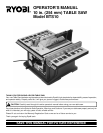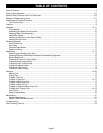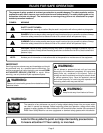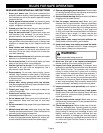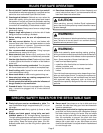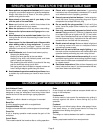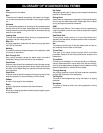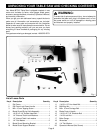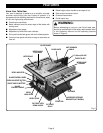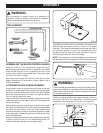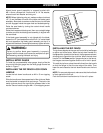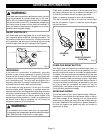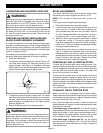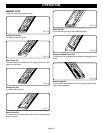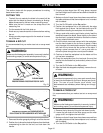
Page 6
SPECIFIC SAFETY RULES FOR THE BTS10 TABLE SAW
■ Never perform any operation freehand, which means
using only your hands to support or guide the workpiece.
Always use either the rip fence or the miter guide to
position and guide the work.
■ Never stand or have any part of your body in line
with the path of the saw blade.
■ Never reach behind, over, or within three inches of the
blade with either hand for any reason.
■ Move the rip fence out of the way when cross-cutting.
■ Never use the rip fence as a cut-off gauge when cross-
cutting.
■ Never attempt to free a stalled saw blade without first
turning the saw off and disconnecting the saw from the
power source.
■ Use a support for the sides and back of the saw table
when sawing wide or long workpieces. To prevent
tipping, use a sturdy "outrigger" support if a table
extension is more than 24 inches long and is attached to
the saw.
■ Avoid kickbacks (work thrown back toward you) by:
Keeping the blade sharp.
Keeping rip fence parallel to the saw blade.
Keeping riving knife, anti-kickback pawls, and blade
guard in place and operating.
Not releasing the work before it is pushed all the way
past the saw blade using a push stick.
Not ripping work that is twisted or warped or does not
have a straight edge to guide along the fence.
■ Avoid awkward operations and hand positions where
a sudden slip could cause your hand to move into the
blade.
■ Check with a qualified electrician if grounding
instructions are not completely understood or if in doubt
as to whether the tool is properly grounded.
■ Use only correct electrical devices: 3-wire extension
cords that have 3-prong grounding plugs and 3-pole
receptacles that accept the tool's plug.
■ Do not modify the plug provided. If it will not fit the
outlet, have the proper outlet installed by a qualified
electrician.
■ Use only recommended accessories listed in this
manual. Blades must be 10" (254 mm) in diameter, rated
for at least 4,800 rpm or higher, with 5/8" (16 mm) arbor
holes. Use of accessories that are not listed may cause
the risk of personal injury. Instructions for the safe use of
accessories are included with the accessory.
■ Double check all setups. Make sure blade is tight and
not making contact with saw or workpiece before
connecting to power supply.
■ Make sure the work area has ample lighting to see
the work and that no obstructions will interfere with safe
operation before performing any work using this tool.
■ Always turn off saw before disconnecting it, to avoid
accidental starting when reconnecting to power supply.
Never leave the table saw unattended while connected
to a power source.
■ Save these instructions. Refer to them frequently and
use to instruct other users. If you loan someone this tool,
loan them these instructions also.
GLOSSARY OF WOODWORKING TERMS
Anti-Kickback Pawls
Device which, when properly installed and maintained, is
designed to stop the workpiece from being kicked back
toward the front of the saw during a ripping operation.
Arbor
The shaft on which a blade or cutting tool is mounted.
Bevel Cut
A cutting operation made with an angled blade.
Compound Miter Cut
A single cut made with both a miter angle and a bevel angle.
Cross Cut
A cut or shaping operation made across the grain of the
workpiece.
Cut-off Stock
The unused material that remains after a cutting operation.
Dado
A non-through cut which produces a square sided notch or
trough in the workpiece.
Featherboard
A device used to help control the workpiece by guiding it
securely against the table or fence during any rip cut
operation.
Freehand
Performing a cut without using a fence, miter gauge, fixture,
hold down clamp, or other proper device to keep the
workpiece from twisting during the cut.
Gullets
The valleys or notches between the teeth in a saw blade.
Gum
A sticky, sap-based residue from wood products.



